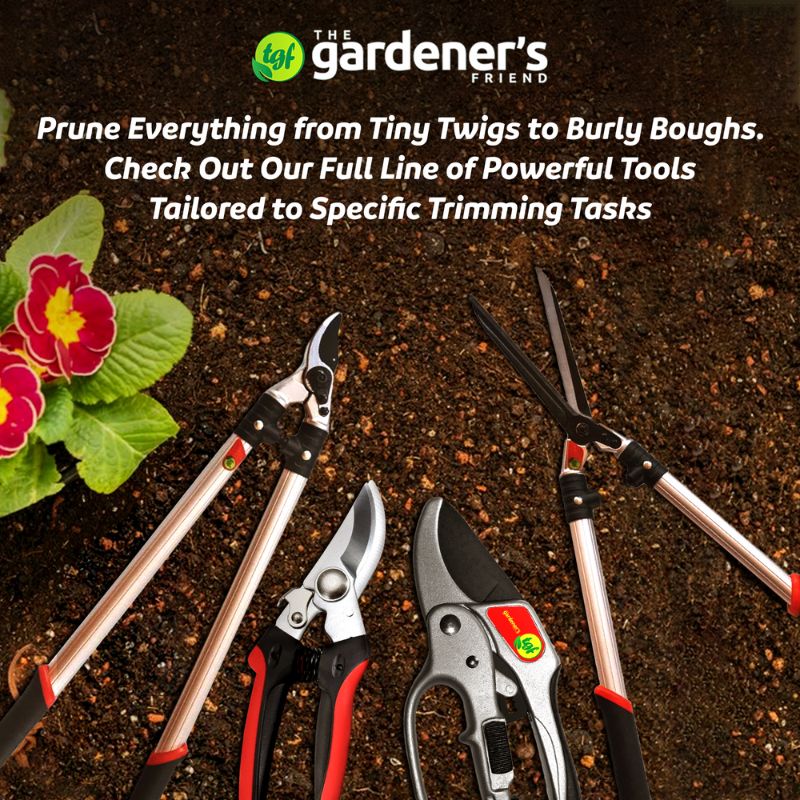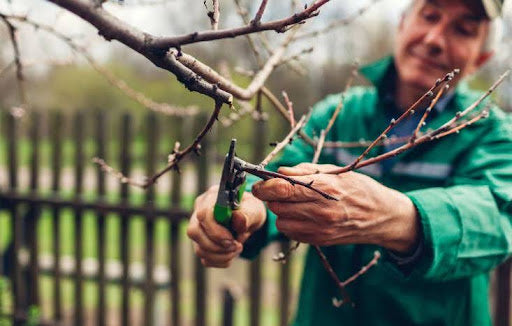Ever wonder why your trusty kitchen scissors turn into a complete flop when you try to prune your plants? It’s because scissors aren’t cut out for tough gardening tasks. A pruning shear is what you need most of the time.
In this post, we’ll talk about the key differences between pruning shears and scissors, shed light on their best use cases, help you understand why picking the right tool is important, and more.
Let’s dive in.
Pruning Shears vs. Scissors: Understanding the Tools
Before anything else, let’s see what these tools are all about.
What are Pruning Shears?
Pruning shears are tailor-made for tough pruning tasks helping gardeners trim stubborn shrubs and plant stems.
They’re a sturdy little tools with a spring-loaded design that opens them up after every snip. This makes them great for elderly gardeners or people with low hand mobility. Some pruners can slice through branches up to two inches thick.
What are Scissors?
Scissors, on the other hand, are a jack-of-all-trades you probably already own and use for tasks like slaying gift wraps. Now, there’s no restriction on using your kitchen scissors in the garden, but gardening scissors are different and commonly called “Snips”.
These are a step up from your normal kitchen knife; they’re light in weight with long, thin blades, making them great for precision work. However, don’t expect garden snips to wrestle with woody stems.
Key Differences Between Pruning Shears and Scissors
Now that you understand both the tools, let’s shed some light on the key differences that might make one a better gardening partner than the other.
Design and Construction
Pruning shears have:
- Longer handles for easier handling
- Shorter blades for more power
- A spring mechanism that helps you trim with less hand force
Scissors? They’re simpler with:
- Equal length blades & handles
- No spring, so your hand does most of the work
Cutting Mechanism
Pruning shears come in different types based on their cutting mechanisms - bypass pruners are ideal for clean slices while anvil pruners are designed to smash through tough stuff.
On the flip side, scissors are great for soft herbs but ineffective against thick branches as they offer a basic shearing action.
Strength and Durability
Garden pruners are forged for battle - the blades are often made with hardened or carbon steel. This not only makes them effective against woody stems but also prolongs their working life.
But, scissors, even garden snips, aren’t heavy-duty like pruners. They work fine on herbs, but might snap or get dull if you push them too hard.
Ergonomics
Pruning shears take the shield for this one as well. They’re built to help gardeners like you work on your plants without straining your hands.
The ergonomic, long handle and the spring mechanism can significantly boost your gardening productivity while preserving your hands’ strength.
You May Also Like: Bypass vs Anvil Pruners (Which One to Choose?)
When to Use Pruning Shears vs. Scissors
Now that you understand the key differences between scissors and garden pruners, let’s briefly discuss their ideal use cases. This will help you know when to reach out for pruning shears vs. scissors.
Best Uses for Pruning Shears
Grab your pruners when your garden throws tough tasks at you. Think woody stems, thick branches, and tangled shrubs.
For instance, you can grab your bypass pruners without thinking twice every spring to tame your rose bushes. For rose plants, you need precise, clean cuts to encourage new growth and bypass pruners can smoothly cut through branches up to one inch thick. They leave no jagged edges that could lead to diseases.
Similarly, a ratchet pruner is your go-to tool if you’re against a monster branch or maybe your hands aren’t as strong as they used to be. They cut in stages, allowing you to prune stubborn material without breaking a sweat.
Other popular use cases of pruning shears include:
- Cleaning storm damage
- Shaping hedges
- Deadheading old shrubs
- Thinning apple trees
- And more
Best Uses for Scissors
Garden-specific snips or scissors are perfect for a job that calls for finesse instead of force. Keep them in your arsenal when you need to harvest soft herbs like mint, parsley, and basil. These tender leaves require delicate handling; you don’t want to bruise them with a clunky tool.
Other use cases of scissors include:
- Deadheading fowers
- Shaping bonsai
- Tidying container gardens
- Cutting edible flowers
- And other delicate jobs that require less force
Drawbacks of Pruning Shears and Scissors
We’ve mostly talked about the strong points of both tools. To pick the right one, you need to know the drawbacks of both. Let’s start with pruning shears:
- They’re typically too bulky for tiny tasks
- They need regular maintenance (Sharpening and cleaning)
On the flip side, scissors:
- Are weak against tough, woody plants
- Get dull fast if misused
- Put more strain on your hands
Scissors vs. Pruning Shears: FAQs
Let’s address some frequently asked questions related to pruning shears vs. scissors.
Can You Use Scissors as Pruning Shears?
For thin, green stems and soft shrubs? Yes. But, don’t try it on thick, dry branches. It’ll put a lot of strain on your hands and you’ll eventually damage the blades.
Are Shears Better than Scissors?
Pruning shears aren’t always better than scissors since both have a unique set of applications. For fine cutting, you can use scissors. For heavy pruning, shears should be your go-to choice.
What is the Difference Between a Pruner and a Shear?
“Pruners” and “Pruning shears” are often the same thing is gardening lingo. They’re a handheld tools for cutting plants. However, “Shear” can also mean a bigger, two-handed hedge trimmer.
Do You Really Need Pruning Shears?
Not always. If your garden only has annuals and herbs, you might get away with scissors. But, for anything woody, shears will save your time and energy and keep your plants flourishing.
Conclusion
There you have it. A detailed comparison of pruning shears with gardening scissors. So, which one’s better? It all comes down to your garden’s personality and your needs; shears are ideal for all kinds of woody work while scissors are built for delicate details.
The important thing? Both help you keep your garden safe and flourishing. Just keep in mind that your plants and hands both need the right tools for the job. Knowing when to switch from pruners to scissors or vice versa can help you save time and energy.


